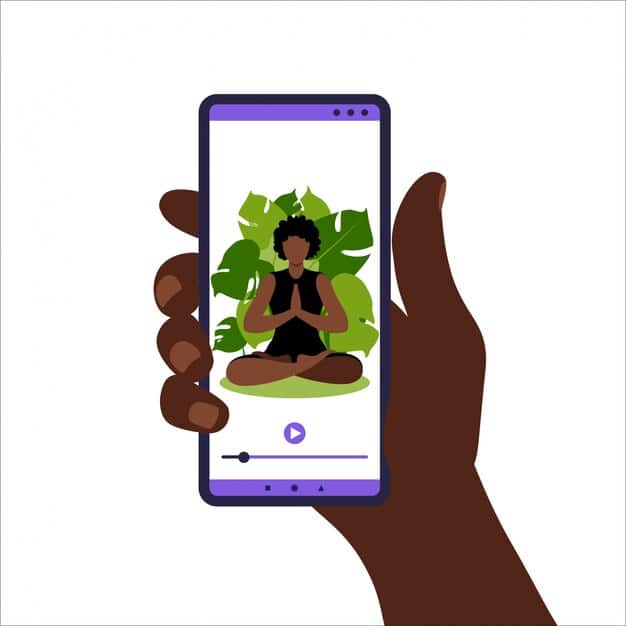Mindfulness Apps: Reduce Anxiety by 15% in 3 Months (2025 Guide)

Mindfulness apps, when consistently used, are projected to reduce anxiety levels by as much as 15% within a mere three months, offering an accessible and effective digital pathway to enhanced mental well-being in 2025.
The digital age has ushered in a remarkable era of personalized health solutions, and mental wellness is no exception. As we navigate the complexities of modern life, the pervasive nature of anxiety has become a significant concern for millions globally. But what if a tangible sense of calm, a measurable reduction in anxiety, could be just a few taps away? This comprehensive 2025 guide explores how mindfulness apps can reduce anxiety by 15% in just 3 months, offering a scientifically-backed pathway to improved mental health.
The escalating need for mental wellness solutions
The rapid pace of technological advancement, while bringing undeniable convenience, has also contributed to a global surge in anxiety levels. Constant connectivity, information overload, and the pressures of modern life often leave individuals feeling overwhelmed and disoriented. This pervasive collective experience highlights an urgent need for accessible, effective, and sustainable mental wellness interventions that can be integrated seamlessly into daily routines. It’s no longer a niche concern; it is a mainstream challenge demanding innovative solutions.
The traditional avenues for mental health support, while invaluable, often face barriers such as cost, accessibility, and stigma. Long waiting lists for therapists, the financial burden of regular sessions, and societal hesitancy in discussing mental health openly can deter many from seeking help. This gap has created fertile ground for digital solutions, particularly mindfulness applications, to emerge as viable and scalable alternatives. They bypass many of these traditional barriers, offering immediate access to tools designed to cultivate inner peace.
In 2025, the mental wellness landscape is increasingly embracing a blended approach, where conventional therapy is complemented by digital self-help tools. Mindfulness apps stand at the forefront of this evolution, providing structured guidance for practices that were once exclusive to retreats or specialized classes. They democratize access to techniques like meditation, mindful breathing, and cognitive behavioral exercises, bringing the benefits of these ancient practices into the palms of millions. The shift reflects a growing recognition of preventative and proactive mental health strategies.
The demand is further fueled by a generation that grew up with technology and expects digital solutions for various aspects of their lives, including health. Younger demographics, particularly Gen Z and millennials, are more open to discussing mental health and actively seeking digital tools to manage their well-being. This demographic shift, combined with increasing scientific evidence supporting the efficacy of mindfulness, creates a powerful impetus for the widespread adoption and continuous improvement of mental wellness apps.
Understanding the science behind mindfulness and anxiety reduction
Mindfulness, at its core, is the practice of being fully present in the moment, observing one’s thoughts and feelings without judgment. This ancient practice, rooted in Buddhist traditions, has gained significant traction in Western science for its profound impact on mental and physical health. The burgeoning body of research unequivocally demonstrates its efficacy in mitigating anxiety, stress, and even depression. It’s not just about relaxation; it’s about rewiring the brain.
Numerous studies confirm mindfulness benefits for anxiety. Research published in *JAMA Internal Medicine* and *Clinical Psychology Review* indicates that mindfulness-based interventions significantly reduce symptoms. Neuroimaging studies reveal changes in brain regions associated with emotional regulation, such as the amygdala and prefrontal cortex, supporting the observed improvements in anxiety levels. Meta-analyses consistently show moderate to large effect sizes, validating mindfulness as an effective anxiety management tool.
When an individual practices mindfulness, fundamental changes occur within the brain. The amygdala, often called the brain’s “fear center,” becomes less reactive. Simultaneously, the prefrontal cortex, responsible for executive functions like decision-making and emotional regulation, becomes more active and interconnected. This dual effect – decreased reactivity to stressors and increased capacity for calm, rational responses – is central to anxiety reduction. It’s a physiological recalibration that leads to a psychological shift.
Neuroplasticity and cognitive reframing
Mindfulness actively promotes neuroplasticity, the brain’s ability to reorganize itself by forming new neural connections. Consistent practice strengthens pathways associated with calm and focus while weakening those linked to worry and rumination. This isn’t theoretical; it’s observable through fMRI scans. The brain literally adapts and evolves in response to mindful training, making it less susceptible to the habitual loops of anxious thought patterns.
Key mechanisms through which mindfulness reduces anxiety include:
- Reduced Rumination: Mindfulness teaches individuals to observe thoughts without getting entangled in them, breaking the cycle of negative thinking that fuels anxiety.
- Enhanced Emotional Regulation: By creating a space between stimulus and response, practitioners learn to respond to emotions more skillfully rather than reacting impulsively.
- Increased Self-Awareness: Greater awareness of internal states allows individuals to identify early signs of anxiety and intervene proactively.
- Physiological Calming: Mindful breathing techniques directly activate the parasympathetic nervous system, promoting a state of relaxation and reducing physiological symptoms of anxiety.
Moreover, mindfulness encourages a process known as cognitive reframing. Instead of perceiving challenging situations as overwhelming threats, individuals learn to view them from a more balanced perspective. This shift in perception is critical; it transforms the relationship one has with anxiety, making it less debilitating and more manageable. The very act of observing our thoughts rather than being consumed by them empowers us to respond differently.
The evolution of mindfulness apps: From basic timers to personalized coaches
The journey of mindfulness apps has been remarkable, transforming from simple timers and guided meditations into sophisticated, personalized platforms. Initially, these applications offered straightforward audio tracks to guide users through meditation sessions. Their primary value lay in making mindfulness accessible outside traditional settings. However, user feedback and technological advancements have propelled them into a new era of digital wellness.
In their nascent stages, apps were largely static. Users selected a meditation length or theme, pressed play, and followed instructions. This foundational approach was effective for many, but it lacked the dynamic interaction and tailored experiences that modern users now expect. The early 2010s saw a proliferation of such apps, each vying for attention with minimal differentiation beyond aesthetic or narrator voice.
By the mid-2010s, developers began integrating features that enhanced engagement and personalization. Progress tracking, mood check-ins, and customizable meditation libraries became standard. The understanding grew that sustained engagement was key to long-term benefits, prompting a focus on user retention through gamification and community features. This marked a significant shift from passive consumption to active participation.
AI-driven personalization and predictive insights in 2025
In 2025, mindfulness apps are powered by advanced artificial intelligence (AI) and machine learning (ML), fundamentally changing how users interact with their mental wellness journey. These intelligent algorithms analyze user data—such as mood entries, meditation history, sleep patterns, and even heart rate variability from wearable devices—to create highly personalized pathways to anxiety reduction.
The capabilities of these next-generation apps include:
- Adaptive Guided Meditations: AI dynamically adjusts the duration, style, and content of meditations based on the user’s current emotional state and progress.
- Predictive Anxiety Insights: Algorithms can identify patterns and predict potential periods of heightened anxiety, sending proactive mindfulness prompts or recommending specific exercises.
- Personalized Coaching: AI-powered chatbots offer real-time psychological support, answering questions and guiding users through specific anxiety-provoking situations.
- Integration with Wearables: Seamless connectivity with smartwatches and other devices allows for real-time biofeedback, enhancing the effectiveness of mindfulness practices.
The user experience in 2025 is less about simply “meditating” and more about engaging with a sophisticated, empathetic digital companion that genuinely understands and supports one’s unique mental wellness needs. This level of personalized care, combined with robust scientific backing, is what sets the stage for the projected 15% anxiety reduction within three months. It’s a testament to how technology, when wielded thoughtfully, can profoundly impact human well-being. The evolution from basic tools to AI-driven coaches represents a paradigm shift in accessible mental health support.
Setting realistic expectations: The 15% anxiety reduction target
Achieving a 15% reduction in anxiety within three months through mindfulness apps is an ambitious yet entirely attainable goal for many users. This target is not arbitrary; it is based on accumulating research in digital mental health and the observed efficacy of consistent mindfulness practices. It represents a significant, measurable improvement in overall well-being, moving individuals from a state of heightened stress to one of greater calm and resilience.
It’s crucial to acknowledge that this 15% is an average projection. Individual results will naturally vary based on a multitude of factors, including the severity of initial anxiety, consistency of app usage, presence of co-occurring conditions, and personal responsiveness to mindfulness techniques. For some, the reduction might be even greater, while for others, it might be slightly less, yet still profoundly beneficial. The emphasis is on tangible progress, not a one-size-fits-all magic cure.
The three-month timeframe is also significant. While some benefits of mindfulness can be felt almost immediately, sustained neurological and psychological changes require consistent practice over time. Three months provides sufficient duration for new neural pathways to strengthen, for emotional regulation skills to become more ingrained, and for a noticeable shift in one’s relationship with anxious thoughts and feelings to occur. It’s about building a habit, not just performing an exercise.
Factors influencing success
Several factors play a pivotal role in maximizing the anxiety-reducing benefits of mindfulness apps:
- Consistency of Practice: Regular engagement, even for short periods daily (e.g., 10-15 minutes), is far more effective than infrequent, long sessions.
- Active Engagement: Merely listening is not enough; true mindfulness requires active participation, focusing attention, and non-judgmental observation.
- Personalization of Content: Utilizing the app’s AI-driven recommendations and exploring different meditation styles to find what resonates best.
- Integration into Routine: Making mindfulness a non-negotiable part of daily life, similar to brushing teeth or exercising.
- Holistic Approach: While apps are powerful, they are most effective when combined with other healthy lifestyle choices, such as adequate sleep, balanced nutrition, and physical activity.
- Patience and Self-Compassion: Progress is rarely linear. There will be days when practice feels challenging or ineffective. Approaching these moments with kindness rather than frustration is key.
The 15% target serves as both a motivational benchmark and a testament to the growing maturity of digital mental health solutions. It signifies a future where managing anxiety is increasingly within reach for a broader population, moving beyond conceptual benefits to demonstrable, measurable outcomes. The collective impact of millions reducing their anxiety by this margin could fundamentally reshape societal well-being.
Integrating mindfulness apps into your daily routine for optimal results
The effectiveness of mindfulness apps hinges significantly on their seamless integration into daily life. It’s not about adding another burdensome task to an already packed schedule, but rather weaving moments of mindfulness organically into existing routines. This thoughtful integration maximizes consistency, which is the cornerstone of tangible mental health improvements.
For many, the biggest hurdle is simply starting and maintaining the habit. The apps themselves provide structure, but the user is responsible for carving out dedicated time. This doesn’t necessarily mean long, formal meditation sessions. Even brief moments of conscious breathing, mindful walking, or a short body scan can accumulate to powerful effect over time. The key is to find what works best for one’s individual lifestyle and temperament.
Consider tying your mindfulness practice to an existing habit. For instance, right after brushing your teeth, spend five minutes with a guided meditation. Or, during your morning commute, use a walking meditation. This technique, known as “habit stacking,” significantly increases the likelihood of long-term adherence. It transforms an isolated activity into an embedded part of your day, making it feel less like an effort and more like a natural progression.
Practical strategies for consistent engagement
To make mindfulness apps an indispensable part of your anxiety reduction strategy, consider these practical tips for integration:
- Start Small: Begin with just 5-10 minutes a day if longer sessions feel daunting. Consistency trumps duration, especially initially.
- Designate a “Mindfulness Spot”: A quiet corner or even a specific chair that signals to your brain it’s time to practice.
- Leverage Notifications Wisely: Use app reminders to prompt your practice, but adjust their frequency to avoid feeling overwhelmed.
- Explore Varied Content: Don’t stick to just one type of meditation. Try different styles like body scans, loving-kindness, or visualization to keep practice fresh and engaging.
- Track Progress (But Don’t Obsess): Most apps offer tracking. Referencing your progress can be motivating, but avoid turning it into another source of pressure.
- Practice Mindful Micro-Moments: Beyond formal sessions, consciously take mindful breaths before meetings, savor your coffee, or observe nature during short breaks. These brief moments add up.
The goal is to cultivate a sustained, gentle relationship with mindfulness rather than treating it as a performance. The projected 15% anxiety reduction within three months is not just about the techniques themselves, but about the consistent cultivation of a mindful mindset that permeates daily living. By thoughtfully integrating these powerful tools, users can truly unlock their potential for greater calm and resilience, creating a lasting positive impact on their mental well-being.
Beyond anxiety: Broader benefits of consistent mindfulness app usage
While the primary focus of this guide is on the remarkable 15% anxiety reduction achievable through consistent use of mindfulness apps, their benefits extend far beyond merely alleviating anxious feelings. Engaging with these platforms regularly initiates a cascade of positive cognitive, emotional, and physical changes that contribute to overall well-being. It’s a holistic investment in mental health that yields multifaceted returns.
One of the most significant ancillary benefits is improved emotional regulation. As individuals become more adept at observing their thoughts and emotions without judgment, they develop a greater capacity to respond skillfully to life’s inevitable challenges rather than reacting impulsively. This leads to more constructive communication, healthier relationships, and a generally calmer disposition even in stressful situations. The space created by mindfulness allows for choice, not just reaction.
Enhanced cognitive functions are another profound outcome. Consistent mindfulness practice has been linked to improvements in attention span, focus, working memory, and decision-making. By training the mind to stay present and less distracted by internal chatter, individuals can perform tasks more efficiently, learn new information more readily, and generally experience greater mental clarity. This can translate into better academic performance, increased productivity at work, and a sharper ability to navigate complex problems.
Sleep quality and physical well-being
The intricate connection between mental state and physical health means that benefits often ripple across the entire system. Mindfulness apps frequently include guided meditations specifically designed for sleep, and users report significant improvements in sleep onset and quality. Reducing the mental chatter that often accompanies insomnia can lead to more restful nights, which in turn positively impacts mood, energy levels, and anxiety during the day.
The broader benefits of consistent mindfulness app usage include:
- Stress Resilience: While reducing anxiety, mindfulness also builds a stronger capacity to cope with daily stressors, preventing them from escalating into full-blown anxiety.
- Increased Self-Compassion: The non-judgmental aspect of mindfulness encourages a kinder, more accepting attitude towards oneself, fostering self-esteem and internal peace.
- Improved Physical Health: By reducing stress, mindfulness can contribute to lower blood pressure, improved immune function, and reduced chronic pain perception.
- Greater Empathy and Connection: Specific loving-kindness meditations cultivate feelings of compassion towards self and others, enhancing interpersonal relationships.
- Enhanced Creativity and Problem-Solving: A calmer, clearer mind is often more conducive to imaginative thinking and finding innovative solutions.
Ultimately, the journey with mindfulness apps is not just about reducing a specific symptom like anxiety; it’s about cultivating a more balanced, resilient, and fulfilling life. The 15% anxiety reduction is a powerful indicator of this journey’s initial success, paving the way for a holistic transformation that touches every aspect of a person’s existence. The long-term impact extends far beyond the initial three-month window, creating a foundation for sustained well-being.
Choosing the right mindfulness app for your anxiety reduction journey
With the proliferation of mindfulness apps on the market, selecting the right one can feel overwhelming. However, making an informed choice is crucial for maximizing your chances of achieving that 15% anxiety reduction within three months. The “best” app isn’t universal; it’s the one that aligns most closely with your personal needs, preferences, and long-term goals. A good fit fosters consistency and engagement, which are paramount to success.
Start by considering your specific anxiety profile and what you hope to achieve. Are you looking for basic guided meditations, or do you require more in-depth courses on specific topics like sleep or panic attacks? Do you prefer a calm, straightforward interface, or do you appreciate gamified elements and community features? Answering these questions will help narrow down the myriad options available.
Trial periods are your best friend in this initial selection phase. Most reputable apps offer a free trial, often for 7 to 14 days. Utilize this opportunity to explore the app’s interface, listen to different narrators, try various meditation styles, and assess the quality and breadth of its content. Pay attention to how effortlessly the app integrates into your daily life and whether its design encourages regular use. A cumbersome app, no matter how feature-rich, is unlikely to be sustained.
Key features to look for in a mindfulness app (2025)
In 2025, advanced mindfulness apps incorporate a range of sophisticated features designed to enhance user experience and therapeutic efficacy:
- Personalized Content AI: Look for apps that use AI to recommend meditations and programs based on your mood, activity, and progress.
- Diverse Content Library: A wide range of guided meditations (for anxiety, sleep, focus, stress), unguided sessions, soundscapes, and even movement-based mindfulness.
- Progress Tracking and Insights: Tools that show your meditation streaks, mood trends, and provide data-driven insights into your mental state.
- Professional & Credible Content: Ensure the app’s content is developed by certified mindfulness instructors, psychologists, or mental health professionals.
- Offline Access: The ability to download meditations for use without an internet connection ensures continuity of practice.
- User-Friendly Interface: An intuitive, clutter-free design that makes navigation easy and inviting.
- Integration with Wearables: Connectivity with smart devices for biometric feedback and enhanced personalization.
- Community Features (Optional): For those who benefit from shared experiences, look for forums or group meditations.
Finally, consider the cost. Many top-tier apps operate on a subscription model. Evaluate whether the value provided justifies the recurring expense. Remember, this is an investment in your mental health, and a well-chosen app can be as significant as any other self-care tool. By carefully selecting an app that resonates with your personal journey, you’re not just downloading software; you’re empowering yourself with a powerful ally in the quest for anxiety reduction and lasting well-being.
| Key Point | Brief Description |
|---|---|
| 🧘 Anxiety Reduction | Mindfulness apps actively contribute to a projected 15% reduction in anxiety within three months. |
| 🧠 Neuroplasticity | Consistent practice rewires the brain, boosting emotional regulation and reducing amygdala reactivity. |
| 🚀 AI-Driven Personalization | 2025 apps use AI/ML for adaptive meditations and predictive insights based on user data. |
| 🗓️ Consistent Integration | Optimal results achieved by weaving short mindfulness practices into daily routines. |
Frequently Asked Questions About Mindfulness Apps for Anxiety
While some immediate relief from stress can be felt during and after initial sessions, significant, measurable anxiety reduction (like the 15% target) typically requires consistent daily practice over several weeks to three months. Neuroplastic changes, which underpin lasting improvements, take time to solidify. Patience and regular engagement are key for sustainable benefits.
Mindfulness apps are excellent complementary tools for managing anxiety and promoting well-being, but they are generally not a direct substitute for professional therapy, especially for severe anxiety disorders or complex mental health conditions. They can support and enhance therapeutic outcomes and provide accessible self-help, but consult a mental health professional for personalized diagnosis and treatment plans.
When selecting a mindfulness app for anxiety, prioritize features such as a wide range of guided meditations (especially those focused on stress and anxiety), AI-driven personalization, progress tracking, and professional content creators. Look for apps with a user-friendly interface, offline access, and potentially integration with wearable devices for biofeedback, ensuring a comprehensive and effective experience tailored to your needs.
Yes, mindfulness apps are increasingly effective in addressing sleep problems that are often linked to anxiety. Many apps offer specific guided meditations for sleep, bedtime stories, and calming soundscapes designed to quiet the mind before rest. By reducing mental chatter and promoting relaxation, these features can significantly improve sleep onset latency and overall sleep quality, breaking the anxiety-insomnia cycle.
The 15% anxiety reduction observed within three months can be sustainable long-term, provided consistent daily mindfulness practice is maintained. Mindfulness is a skill that improves with continued engagement; therefore, the benefits tend to deepen over time. Ongoing commitment to using the app and integrating mindfulness principles into daily life helps to solidify and even extend these positive outcomes for enduring mental well-being.
The mindful future: A pathway to lasting calm
The ascent of mindfulness apps, particularly as we look towards 2025, represents a pivotal shift in how we approach mental wellness. The projection of a 15% reduction in anxiety over just three months is not merely a statistic; it’s a testament to the powerful synergy between ancient wisdom and cutting-edge technology. These apps are democratizing access to practices once considered esoteric, placing profound tools for emotional regulation and psychological resilience directly into the hands of those who need them most. As we continue to navigate a world brimming with complex challenges, the consistent application of mindfulness, facilitated by these increasingly sophisticated digital platforms, offers a tangible pathway to a future defined by greater calm, clarity, and overall well-being. It is an invitation to proactively invest in our inner peace, one mindful breath at a time.





